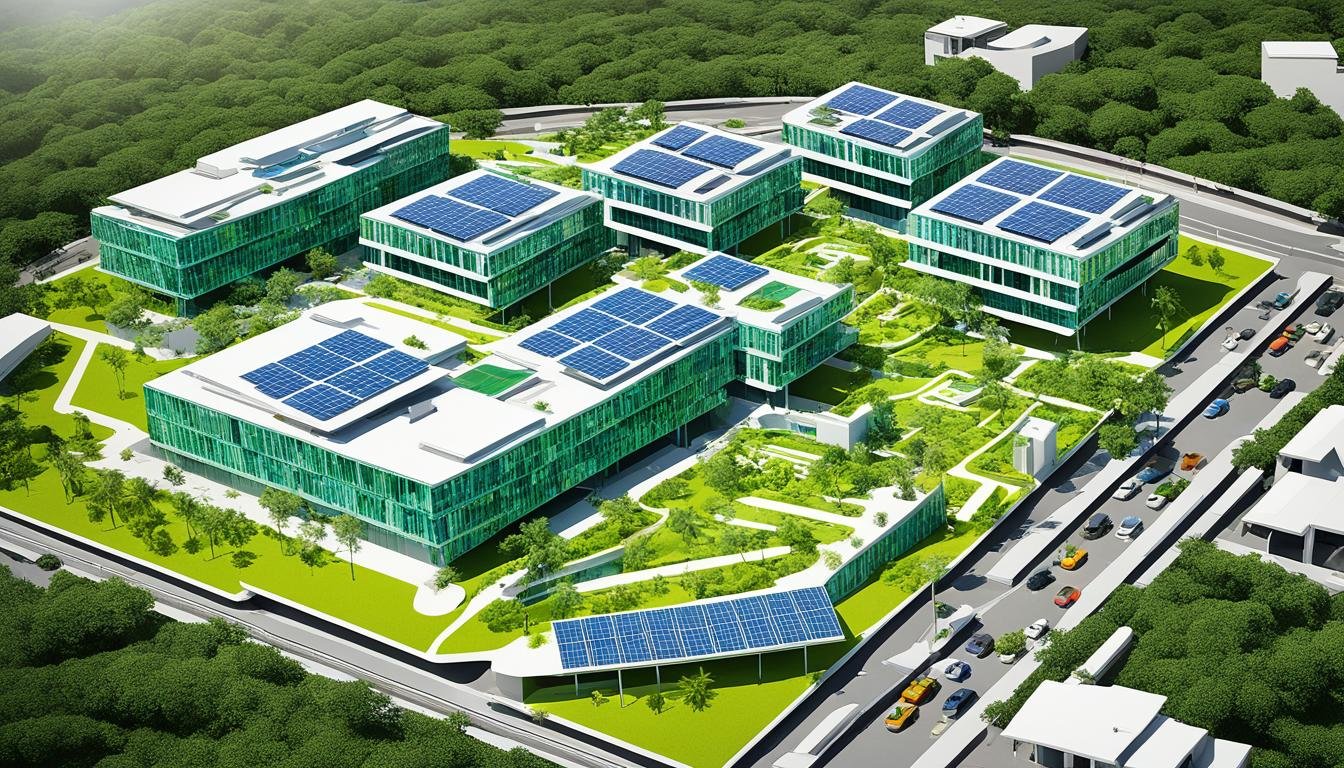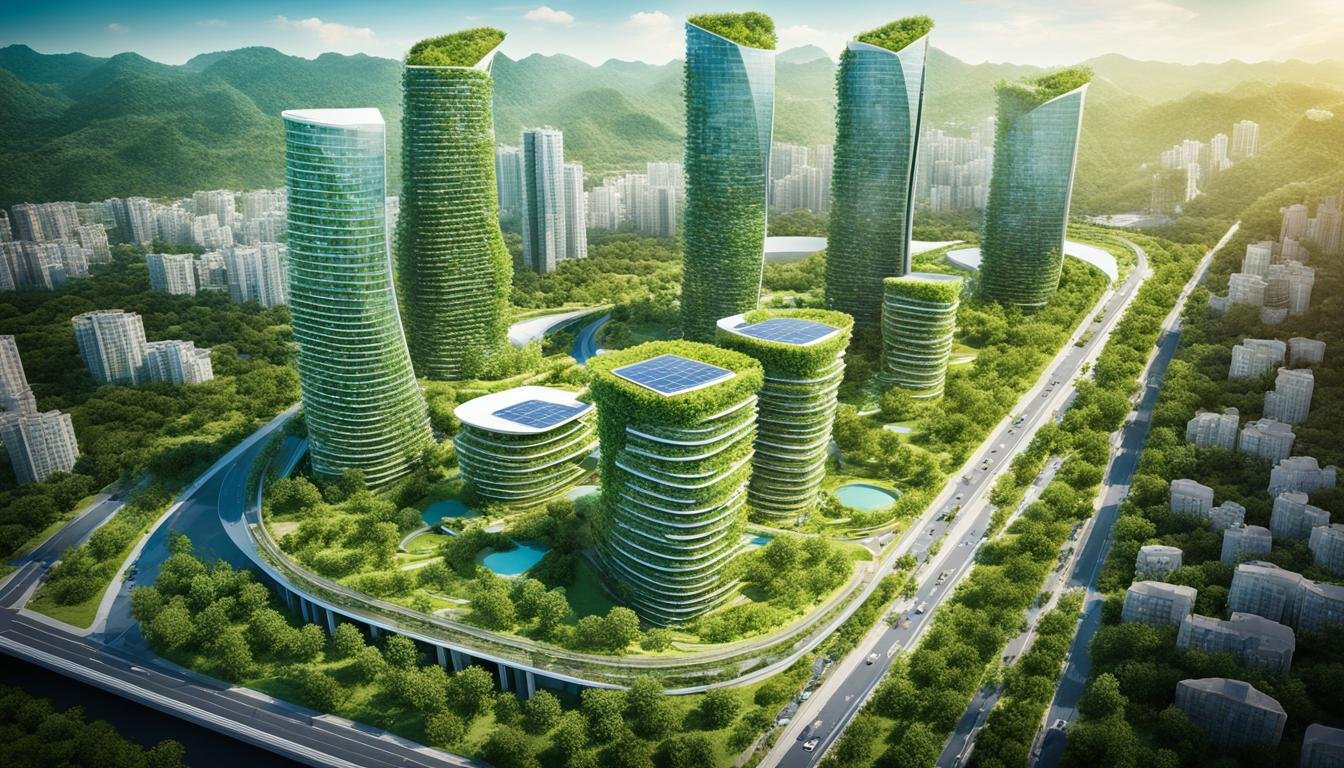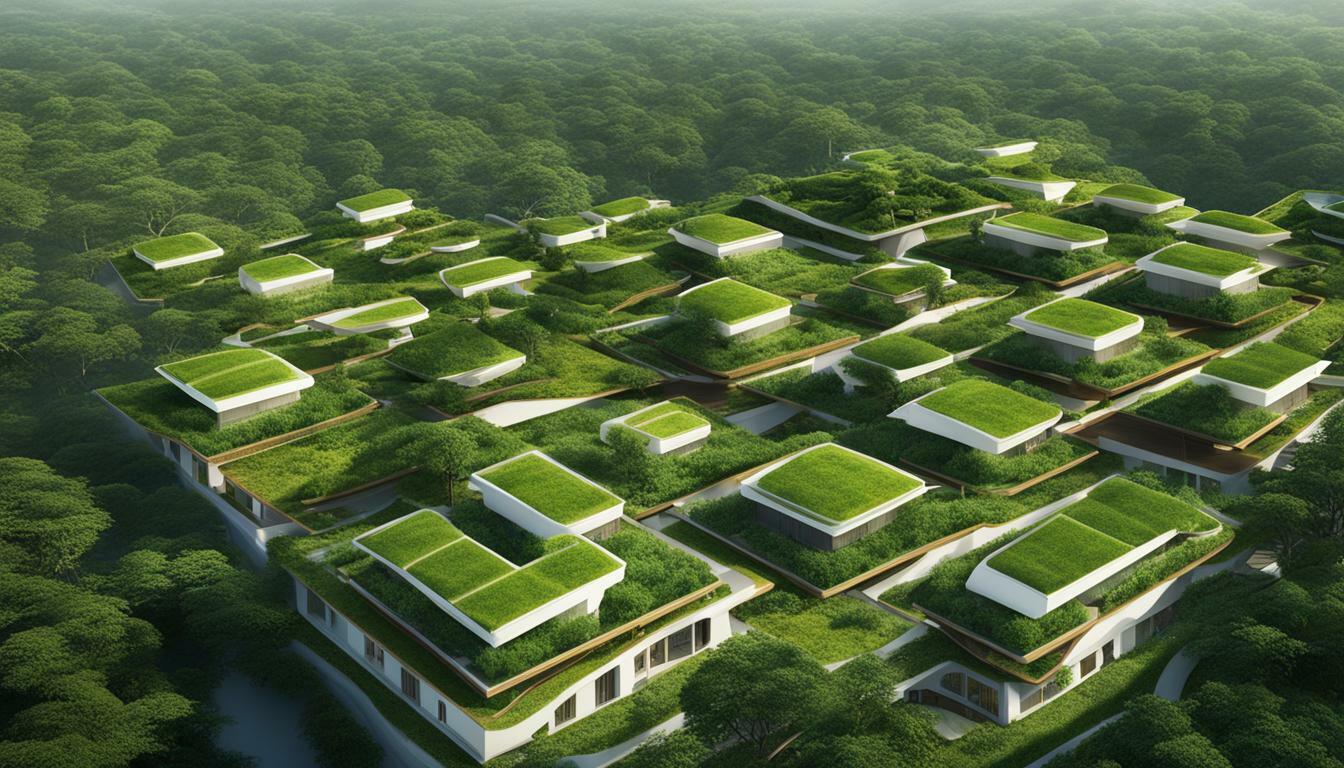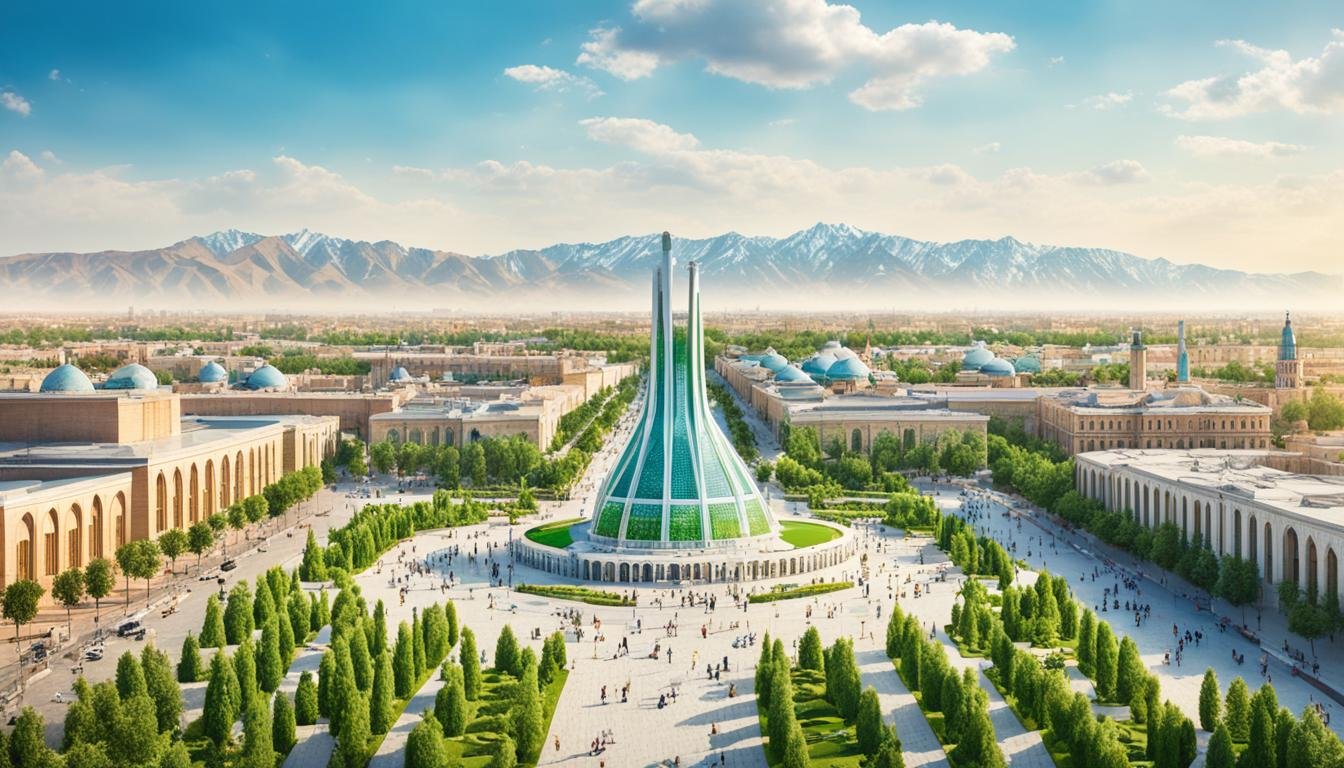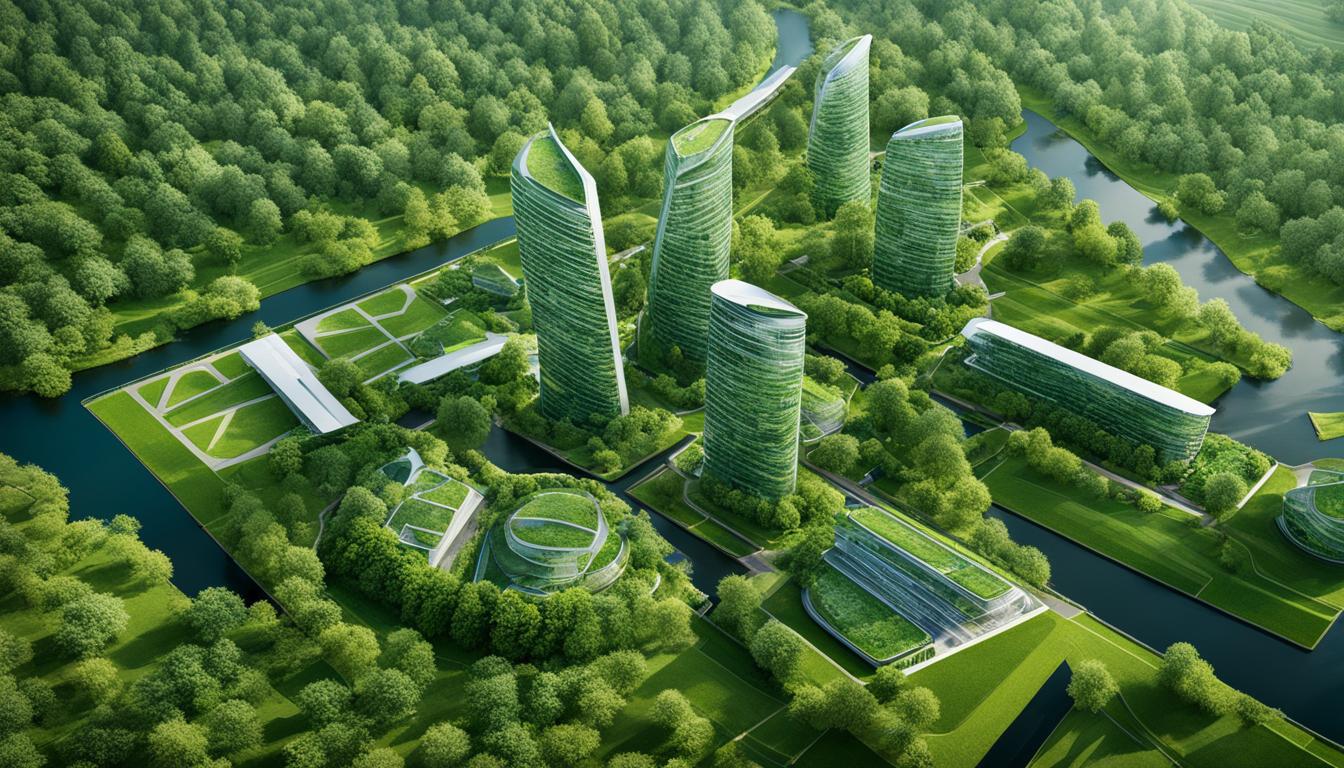Yemen Top Green Buildings
Yemen is home to some of the most remarkable green buildings in the world. The ancient city of Sana’a boasts a collection of mud buildings that have stood the test of time, blending seamlessly with the surrounding landscape. These eco-friendly structures are not only a testament to Yemen’s rich architectural heritage but also exemplify sustainable architecture in Yemen.
Architects and builders in Yemen have embraced the use of mud as a building material, creating structures that are not only aesthetically pleasing but also environmentally friendly. The resilience of these buildings to extreme weather conditions, such as heatwaves and floods, makes them a top choice for sustainable development projects in Yemen. Mud buildings have proven to be energy-efficient, providing excellent insulation and reducing the need for artificial heating and cooling.
The revival of raw-earth construction techniques has gained momentum in recent years, as architects around the world recognize the benefits of using locally sourced and recyclable materials. In Yemen, this ancient tradition has been reinvigorated by green construction companies that prioritize sustainability and cultural preservation. By blending the past and the future, these companies create green buildings that not only reduce carbon emissions but also celebrate Yemen’s architectural heritage.
As we strive for a more sustainable future, Yemen’s green buildings serve as a shining example of what can be achieved by embracing eco-friendly construction practices. The preservation of these architectural wonders and the promotion of sustainable architecture in Yemen are vital for the well-being of future generations.
Key Takeaways:
- Yemen is home to remarkable green buildings that blend seamlessly into the landscape.
- Mud buildings in Yemen are resilient to extreme weather conditions and offer energy efficiency.
- Green construction companies in Yemen are leading the way in sustainable architecture.
- The revival of raw-earth construction techniques promotes eco-friendly building designs.
- Preserving Yemen’s architectural heritage is crucial for a sustainable future.
The Environmental Impact of Traditional Construction
The construction industry plays a significant role in global carbon dioxide emissions, contributing to the environmental challenges we face today. Traditional construction methods, such as the use of concrete, have a substantial environmental impact. However, in Yemen, green construction companies are spearheading a movement towards more environmentally friendly construction practices, striving to minimize the industry’s carbon footprint.
These forward-thinking companies recognize the urgent need for sustainable building practices and are actively adopting strategies to reduce the environmental impact of construction. They are embracing alternative materials, such as mud, which have a significantly lower carbon footprint compared to conventional building materials. By incorporating mud and other environmentally friendly materials into their projects, green construction companies in Yemen are setting the standard for sustainable and eco-conscious construction.
Furthermore, these companies are not only focusing on material choices but also prioritizing energy-efficient designs. By incorporating energy-saving features into their buildings, such as passive solar design, efficient insulation, and natural ventilation, they are further reducing the environmental impact of construction. These innovative designs not only contribute to a more sustainable future but also create comfortable and energy-efficient spaces for occupants.
Mud is a versatile and sustainable material that offers numerous benefits in construction. It has a low carbon footprint, can be locally sourced, and provides excellent thermal properties. Mud buildings have stood the test of time and continue to provide an example of environmentally friendly construction.
The Benefits of Environmentally Friendly Construction:
- Lower carbon footprint: By utilizing mud and other environmentally friendly materials, green construction companies in Yemen are significantly reducing carbon emissions associated with construction.
- Improved energy efficiency: Incorporating energy-saving designs and features ensures reduced energy consumption and creates more sustainable buildings.
- Preservation of natural resources: Utilizing mud and locally sourced materials reduces the reliance on non-renewable resources and helps preserve natural ecosystems.
- Resilience to climate change: Environmentally friendly buildings are better equipped to withstand the challenges of climate change, contributing to long-term sustainability.
Through their commitment to environmentally friendly construction practices, green construction companies in Yemen are making a positive impact on the environment and showcasing the potential for sustainable development in the region.
Case Study: Almanarah Eco-Resort
An excellent example of environmentally friendly construction in Yemen is the Almanarah Eco-Resort. This sustainable resort, developed by a leading green construction company, showcases the successful integration of mud construction and eco-conscious design principles. The resort’s buildings, constructed primarily with mud and other locally sourced materials, blend harmoniously with the surrounding landscape while offering exceptional energy efficiency and thermal comfort for guests.
| Key Features of Almanarah Eco-Resort | Benefits |
|---|---|
| Passive solar design and natural ventilation | Reduces the need for artificial heating and cooling, resulting in lower energy consumption. |
| Green roofs and rainwater harvesting systems | Contribute to improved water management and enhanced biodiversity. |
| Use of locally sourced materials | Supports the local economy and reduces the carbon footprint associated with transportation. |
| Minimal environmental disturbance during construction | Preserves the natural surroundings and minimizes environmental impact. |
Almanarah Eco-Resort stands as a testament to the possibilities of environmentally friendly construction in Yemen, demonstrating that sustainable practices can be integrated without compromising on aesthetics or comfort.
The Revival of Raw-Earth Construction
Architects around the world are rediscovering the benefits of raw-earth construction. This ancient building technique involves using materials like mud, straw, and bamboo to create sustainable and energy-efficient structures. In Yemen, there is a growing interest in green building designs that prioritize sustainability and incorporate traditional construction methods.
These sustainable development projects aim to create buildings that are not only environmentally friendly but also culturally significant, reflecting Yemen’s rich architectural heritage. By embracing raw-earth construction, architects in Yemen are able to combine modern design principles with traditional building techniques, resulting in unique and visually striking structures.
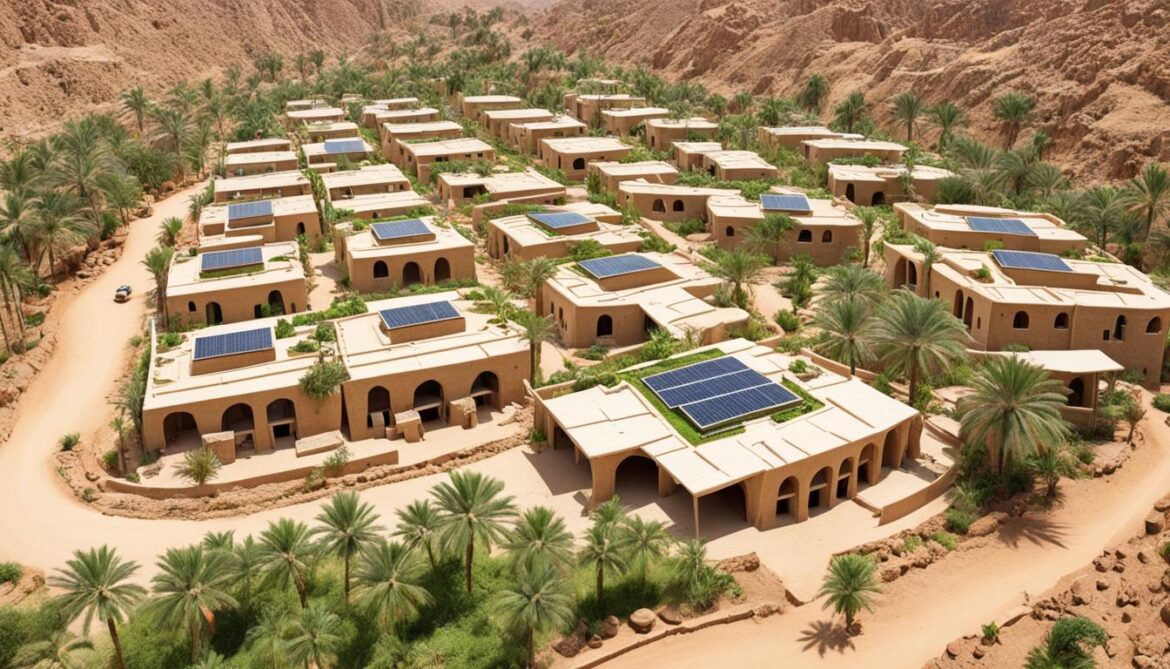
Raw-earth construction provides numerous benefits, both for the environment and for the local communities. By using locally sourced materials, these projects reduce the carbon footprint associated with transportation. Additionally, the use of natural materials like mud and straw increases the energy efficiency of the buildings, minimizing the need for artificial heating and cooling. This approach not only conserves resources but also promotes a healthier and more sustainable way of living.
Furthermore, raw-earth construction projects in Yemen prioritize the preservation of cultural heritage. By incorporating traditional building techniques and drawing inspiration from historical architecture, these projects pay homage to Yemen’s rich architectural legacy while creating functional spaces for a modern lifestyle.
The revival of raw-earth construction in Yemen is a testament to the ingenuity and creativity of architects who are committed to sustainability and preserving the unique character of the region. Through these green building designs and sustainable development projects, Yemen is redefining its architectural landscape and setting an example for the rest of the world.
The Resilience of Mud Buildings
Mud buildings in Yemen have proven to be remarkably resilient to extreme weather events, such as heatwaves, floods, and earthquakes. These structures, which have been inhabited for thousands of years, provide excellent insulation and thermal mass, keeping occupants cool in summer and warm in winter. The energy-efficient nature of mud buildings reduces the need for artificial heating and cooling, making them a sustainable choice for the future. Green construction companies in Yemen are embracing this architectural technique to create resilient and environmentally friendly buildings.
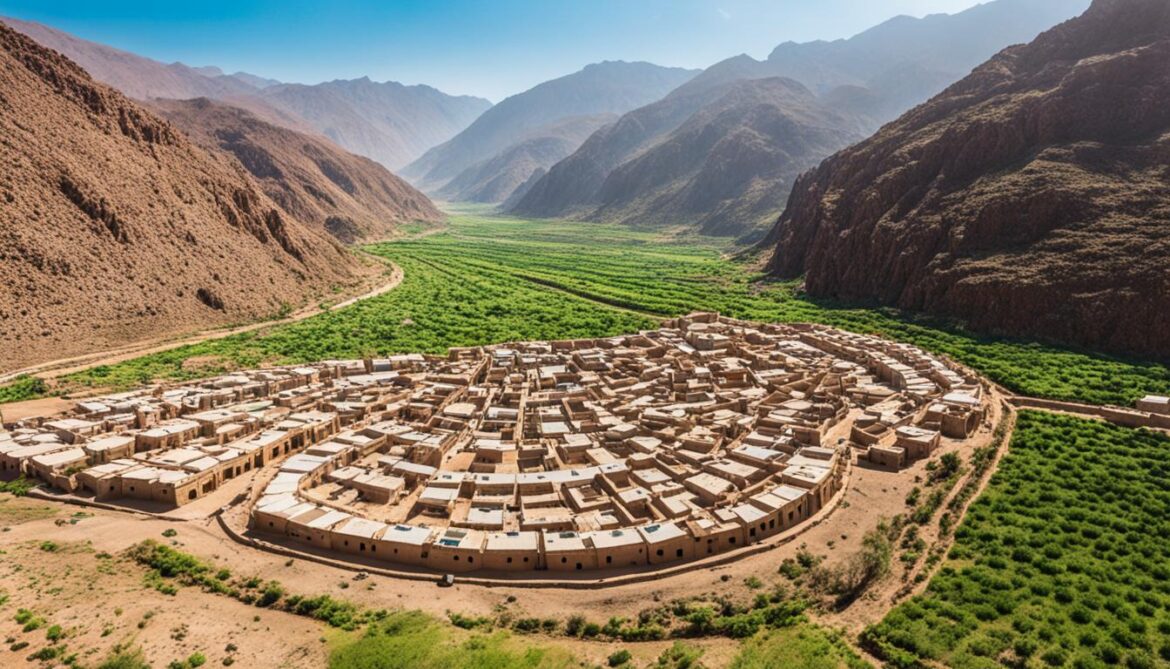
| Benefits of Mud Buildings | Resilience to Extreme Weather | Energy Efficiency |
|---|---|---|
| 1. Natural and locally sourced materials | 1. Provide insulation against heatwaves | 1. Reduce the need for artificial heating and cooling systems |
| 2. Low environmental impact | 2. Withstand floods and heavy rainfall | 2. Retain thermal mass, keeping occupants comfortable |
| 3. Abundance of mud as a building material | 3. Stand up well to earthquakes | 3. Promote energy efficiency and reduce carbon emissions |
Mud buildings offer a range of benefits, from their use of natural and locally sourced materials to their resilience in the face of extreme weather. By incorporating traditional mud building techniques, green construction companies in Yemen are creating structures that are not only environmentally friendly but also durable and energy efficient.
Building Resilience to Extreme Weather Events
Mud buildings have a proven track record of withstanding extreme weather events. In Yemen, where heatwaves, floods, and earthquakes are common, these structures have stood strong for centuries. The thick mud walls provide insulation against heatwaves, keeping the interiors cool even in scorching temperatures. Additionally, mud buildings can withstand heavy rainfall and floods, preventing water penetration and damage to the structure. When it comes to earthquakes, the flexibility of mud as a material helps absorb and dissipate seismic energy, minimizing the risk of collapse.
Energy Efficiency and Environmental Sustainability
Mud buildings are inherently energy efficient due to their thermal properties. The dense mud walls act as a natural insulator, preventing heat transfer between the interior and exterior. This insulation helps keep the interiors cool in summer and warm in winter, reducing the need for artificial heating and cooling systems. By minimizing the reliance on energy-intensive HVAC systems, mud buildings significantly lower carbon emissions and contribute to a more sustainable built environment. Additionally, mud is a locally available and eco-friendly material, making it a sustainable choice for construction in Yemen.
“Mud buildings are a perfect example of how traditional construction methods can marry resilience, energy efficiency, and environmental sustainability. By leveraging the abundance of mud in Yemen, green construction companies are creating buildings that are not only adaptable to extreme weather conditions but also contribute to a greener future.”
In summary, mud buildings in Yemen demonstrate remarkable resilience and energy efficiency. These structures have proven their ability to withstand extreme weather events and provide comfortable living conditions while minimizing environmental impact. Green construction companies in Yemen are leading the way in utilizing mud as a building material to create resilient and environmentally friendly buildings that embrace both tradition and innovation.
The Importance of Mud as a Building Material
Mud, a sustainable alternative to materials like concrete, is gaining recognition as a vital component of eco-friendly buildings in Yemen. Unlike concrete, which has a high carbon footprint, mud is readily available and has a low impact on the environment. Additionally, it can be locally sourced and is fully recyclable, making it an ideal choice for sustainable architecture in Yemen.
One of the significant advantages of mud buildings is their excellent thermal properties. Mud acts as a natural insulator, regulating temperature and reducing the need for energy-intensive heating and cooling systems. This natural insulation keeps the interior cool during hot summer months and warm during colder winters, promoting energy efficiency and reducing reliance on artificial climate control.
“Mud, as a building material, offers unique benefits in terms of sustainability and energy efficiency. Its availability and low environmental impact make it an attractive option for architects and builders in Yemen.”
Architects and builders in Yemen have embraced the abundance of mud as a building material for creating sustainable and energy-efficient structures. By utilizing this natural resource, they are contributing to the development of eco-friendly buildings in Yemen that align with sustainable construction practices. These structures not only reduce the environmental impact but also reflect Yemen’s rich architectural heritage.
Advantages of Mud as a Building Material:
- Mud is a sustainable and environmentally friendly alternative to concrete.
- Mud can be locally sourced and is fully recyclable.
- Mud buildings offer excellent thermal properties, reducing energy consumption.
In conclusion, the use of mud as a building material in Yemen’s top green buildings is a testament to its importance in sustainable architecture. The abundant availability, low environmental impact, and thermal properties make it an ideal choice for eco-friendly buildings in Yemen. By embracing mud as a building material, architects and builders are creating sustainable, energy-efficient, and environmentally friendly structures that contribute to a greener future.
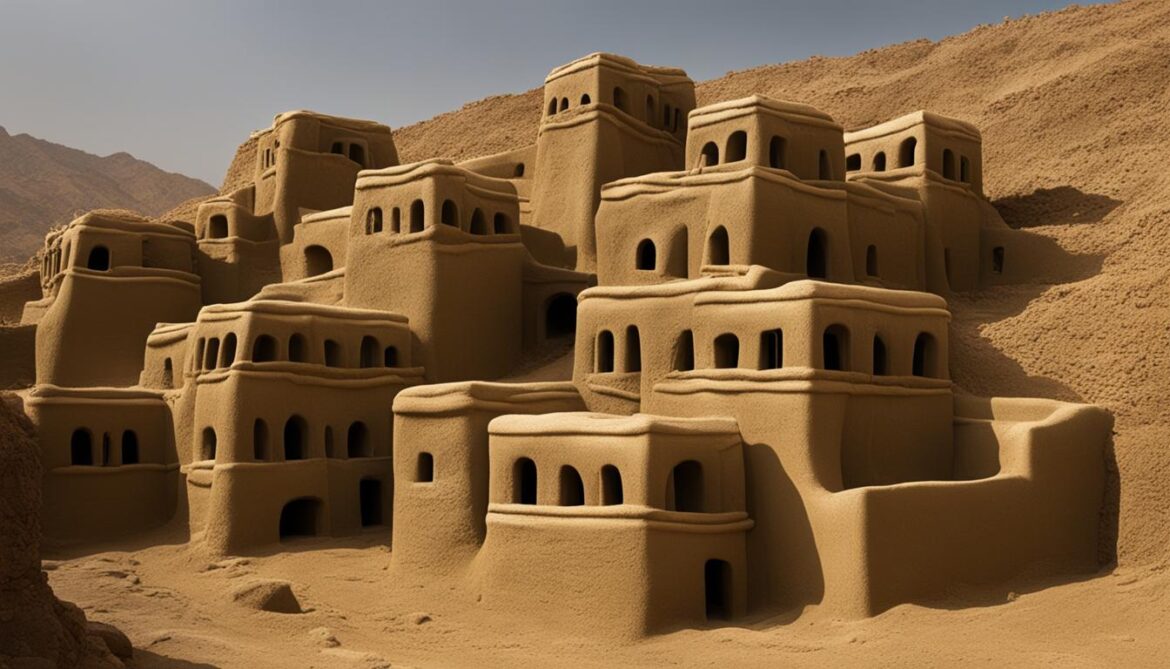
The Ancient Tradition of Mud Architecture
Mud architecture has a long history in Yemen, stretching back thousands of years. The city of Djenné in Mali is known for its magnificent earthen architecture, including the Great Mosque, the largest mud building in the world. The tradition of mud architecture in Yemen and other regions showcases the ingenuity of ancient builders who used local materials to create durable and sustainable structures.
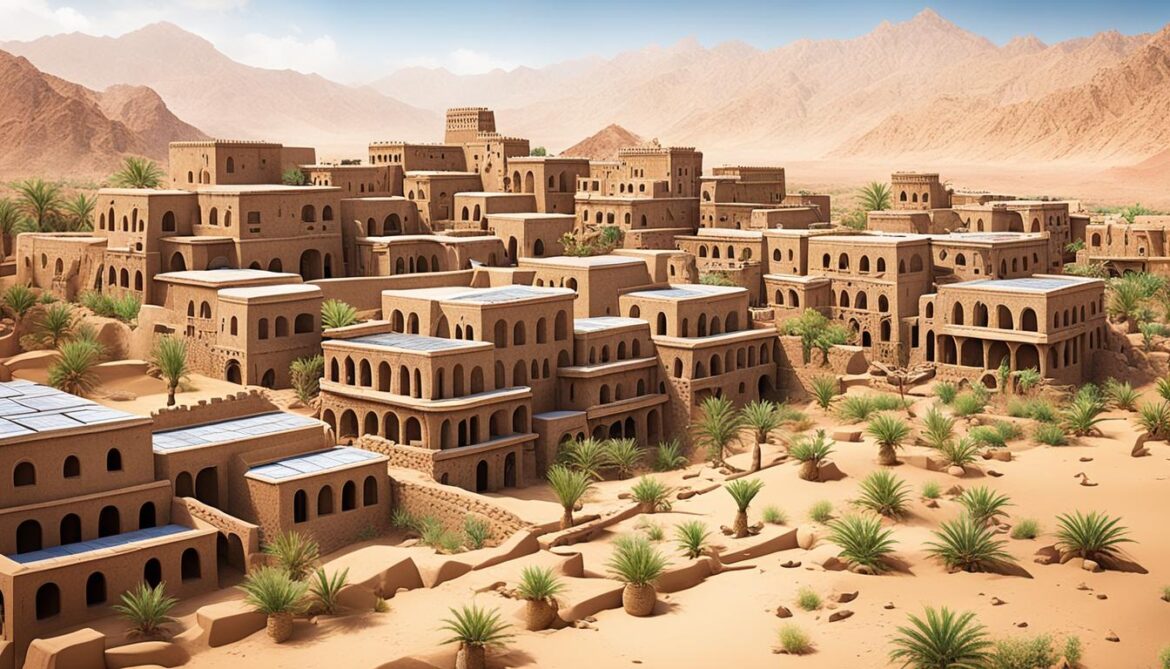
This ancient tradition is being revived by green construction companies in Yemen, who are incorporating mud building techniques into their projects to promote sustainable infrastructure.
The Future of Sustainable Construction
Mud buildings are paving the way for sustainable construction in Yemen and beyond. With the growing urgency to address the climate crisis and reduce carbon emissions, architects and builders are turning to environmentally friendly methods to create a brighter future for our planet.
The use of mud as a building material offers several advantages that make it ideal for sustainable construction. Firstly, mud has a low environmental impact compared to traditional construction materials like concrete. It can be locally sourced and easily replenished, reducing the need for transportation and minimizing the overall carbon footprint. Secondly, mud buildings are energy-efficient. The natural thermal properties of mud provide insulation, keeping the interiors cool in summer and warm in winter. As a result, the reliance on energy-intensive heating and cooling systems is reduced, contributing to energy savings and decreased carbon emissions.
“Mud buildings are not just a return to the past but represent a leap into the future of sustainable construction.” – Ahmed Abdullah, Architect
In addition to its environmental benefits, mud construction also offers resilience to extreme weather events. Mud buildings have demonstrated their ability to withstand heatwaves, floods, and earthquakes, which are becoming increasingly frequent due to climate change. By integrating mud construction techniques, architects can create buildings that are not only sustainable but also resilient to the challenges posed by a changing climate.
In Yemen, green construction companies are at the forefront of the sustainable construction movement. These companies prioritize sustainability in their projects, utilizing mud as a building material to create green buildings that harmonize with the environment and contribute to the overall well-being of the community. By embracing traditional building techniques and incorporating modern design principles, these companies are setting an example for the construction industry.
The Promise of Yemen’s Top Green Buildings
Yemen’s top green buildings, constructed by these innovative green companies, demonstrate the potential for sustainable architecture in the region. These buildings prioritize energy efficiency, environmental preservation, and the well-being of occupants. They showcase the unique beauty of mud architecture while incorporating modern amenities and design elements.
One of the notable green buildings in Yemen is “Al-Nahdain Tower,” situated in the heart of Sana’a. This towering structure features a stunning mud facade, designed to blend seamlessly with the city’s historic architecture. The interior spaces are designed to maximize natural light and ventilation while incorporating sustainable materials and technologies. Al-Nahdain Tower serves as a symbol of Yemen’s commitment to sustainable development and showcases the infinite possibilities of mud construction.
The dedication of green construction companies in Yemen to sustainable building practices not only creates greener cities but also helps to preserve Yemen’s rich architectural heritage. By embracing mud as a building material and integrating it with modern construction techniques, these companies contribute to the preservation of cultural identity while paving the way for a sustainable future.
| Advantages of Mud Buildings | Examples of Green Buildings in Yemen |
|---|---|
|
|
Mud buildings, with their low environmental impact, energy efficiency, and resilience, are undoubtedly the future of sustainable construction. As the world faces the challenges of climate change, green construction companies in Yemen are leading the way, demonstrating that sustainability and modern design can coexist.
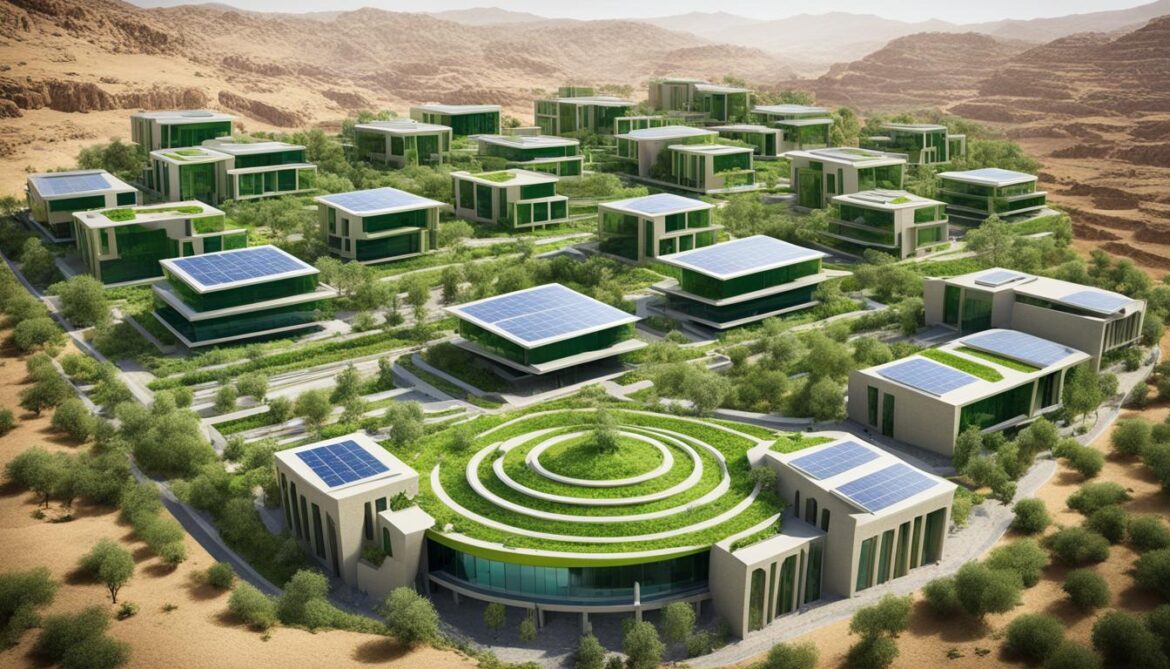
The Preservation of Yemen’s Architectural Heritage
Yemen’s architectural heritage, including its remarkable mud buildings, must be preserved for future generations. These structures are not only culturally significant but also offer valuable insights into sustainable construction methods. Efforts are underway to document and restore the ancient architecture of Yemen, guided by UNESCO and other organizations. Sustainable development projects in Yemen aim to balance the preservation of architectural heritage with modern-day needs, creating a harmonious blend of past and future.
| Importance of Preservation | Sustainable Development | Guided by UNESCO |
|---|---|---|
|
Preserving Yemen’s architectural heritage ensures that future generations can appreciate the cultural significance of the mud buildings and learn from the sustainable construction methods employed. |
Sustainable development projects in Yemen seek to integrate the preservation of architectural heritage with modern-day needs. By incorporating eco-friendly practices, these projects demonstrate a commitment to sustainable development. |
UNESCO and other organizations provide guidance and support for the documentation and restoration of Yemen’s ancient architecture. Their expertise ensures that preservation efforts are carried out effectively and in line with international standards. |
In preserving Yemen’s architectural heritage, the country not only safeguards its past but also creates a sustainable foundation for the future. By embracing the lessons from the past and combining them with modern sustainable practices, Yemen’s top green buildings become symbols of resilience, cultural heritage, and a commitment to sustainable development.
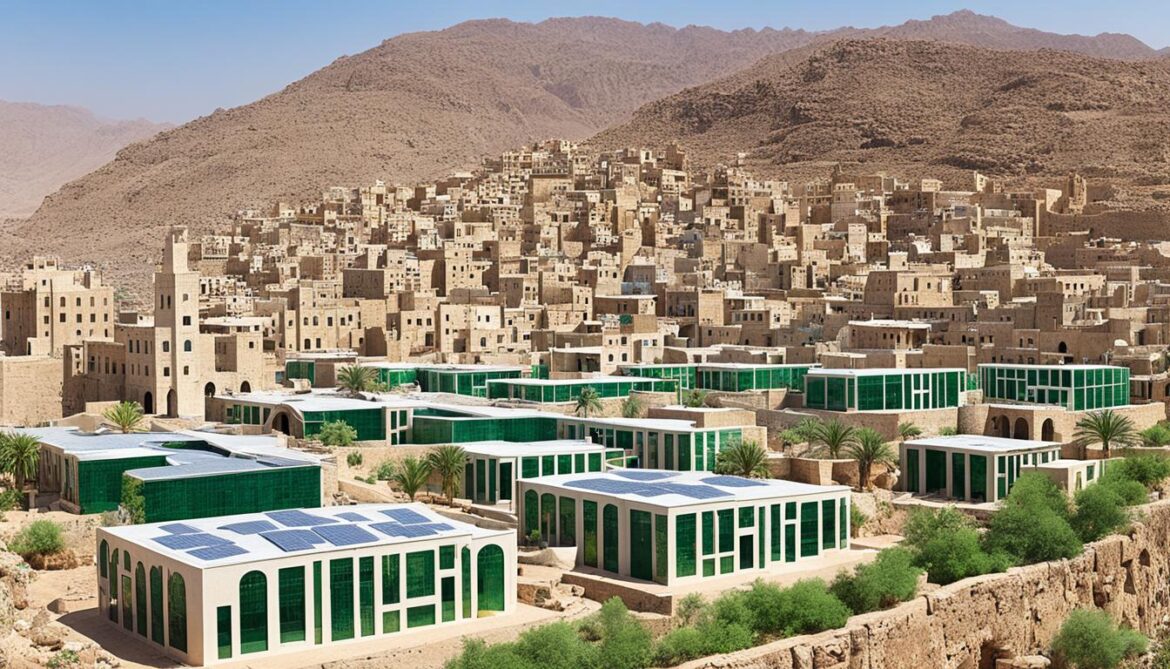
Quoting UNESCO:
“The preservation of Yemen’s architectural heritage is crucial for the cultural identity of the country and a source of inspiration for sustainable development in the region. These mud buildings represent not only an exceptional testimony to ancient building techniques but also offer valuable insights into sustainable construction methods.” – UNESCO
Conclusion
Yemen’s top green buildings, with their mud construction and environmentally friendly design, are spearheading the movement towards sustainable architecture in Yemen. These buildings serve as shining examples of the benefits derived from using natural and locally sourced materials, contributing to enhanced energy efficiency and resilience in the face of climate change. The forefront of this sustainable construction revolution in Yemen is occupied by green construction companies that have embraced traditional building techniques.
By prioritizing sustainability and cherishing the exceptional architectural heritage of Yemen, these green buildings are setting a new global standard for eco-friendly construction. Their remarkable use of mud and other natural materials not only reduces carbon emissions but also promotes the preservation of the environment. Through their commitment to sustainable development, these innovative buildings are paving the way for a brighter future.
Yemen’s top green buildings exemplify the significant strides being made in sustainable architecture, not just within Yemen but on a global scale. Their achievements serve as a powerful reminder that a sustainable future is within our reach, provided we prioritize the use of eco-friendly materials and adopt green construction practices. As Yemen continues to celebrate and embrace its rich architectural heritage, these buildings stand as beacons of hope, inspiring us all to shape a more sustainable world.



